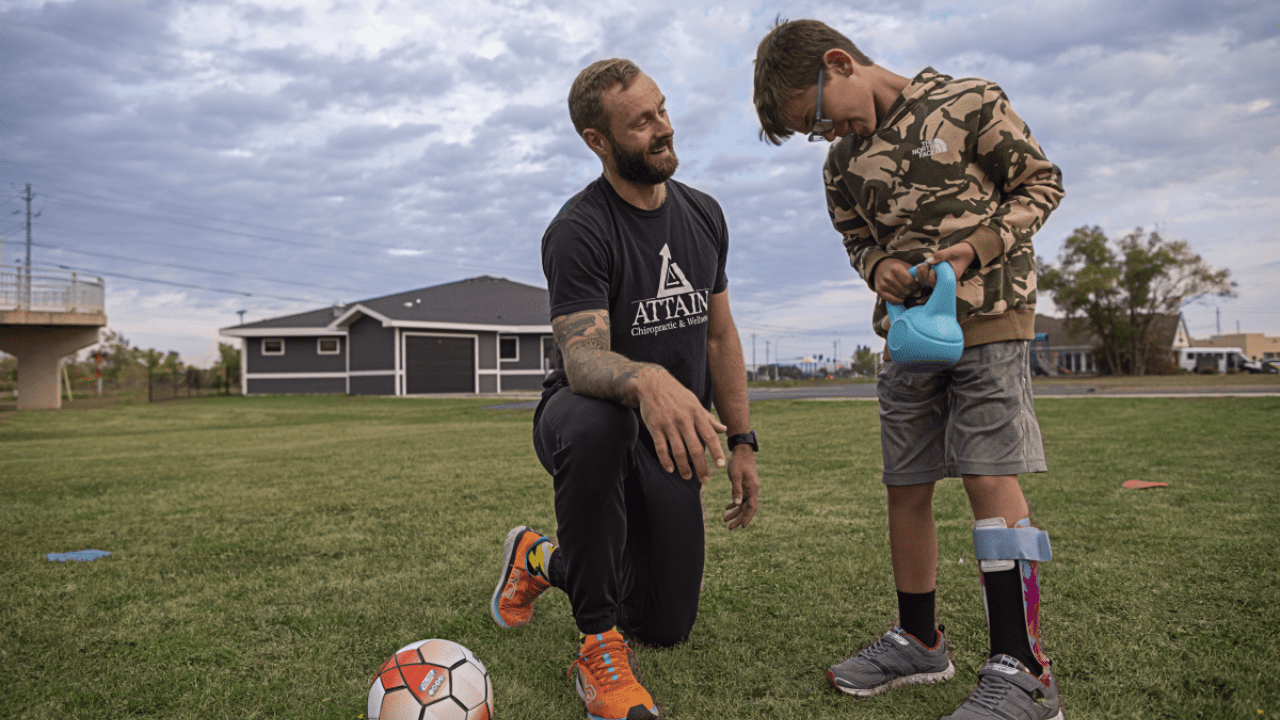Chiropractic Careers: A Creative Practice in Sports and Mobility
Taylor Peterson, DC built a creative chiropractic sports practice: brings his love for sports and functional movement into his work in Rochester, MN
If you’re considering chiropractic school, you are probably wondering what your future career might look like. The truth is, one of the best parts of working as a chiropractor is the freedom you have to build your own business around your interests. Taylor Peterson, DC, is a great example of how you can build a creative chiropractic sports practice that fits your interests.
Opening your own business is not easy, but with a vision and a good support system around you, your chiropractic career could be just about anything you can imagine.
Bringing a CrossFit Background into his Chiropractic Practice
Before going to chiropractic school, Dr. Peterson was an athlete and a CrossFit coach. Now, at Attain Chiropractic and Wellness, a clinic his wife Danielle Priestley, DC founded and runs in Rochester, his patient-base is mostly athletes and active individuals from all different backgrounds. He does a lot of extremity work and sees patients about 12 hours a week. He also does personal training, elite athlete training, and nutrition consulting.
Starting Adaptive Athletics
What makes up the rest of his week? He spends 15 to 17 hours a week working with athletes through his Adaptive Athletics program. Through the program, he provides one-on-one functional mobility training for kids and teens with a wide range of diverse physical and intellectual needs.
It all started with a question. “Can I ask you about your scar? My son has one just like it.” Dr. Peterson was coaching CrossFit when this question turned into a conversation with a mom about her son’s scar from an Endoscopic Third Ventriculostomy with Choroid Plexus Coagulation (ETV-CPC), and how he could help him.
Two years later, he’s working with 17 athletes in classes designed to be challenging, fun, and functional. Many of his athletes go to therapy or the doctor two to three times a week, “so when they come to me it’s ‘let’s play games, let’s have fun,’” he explained. “If we can get them feeling and acting more like themselves and having confidence, that’s a big thing in our program.”
Finding Motivation in His Own Experience
Dr. Peterson’s chiropractic knowledge informs his Adaptive Athletic sessions, “I do take a lot of the neuromuscular anatomy and nervous system work to structure these sessions. It all kind of comes second nature, I don’t think about it too much.”
Dr. Peterson was lucky, and the effects of his brain tumor (the cause for his surgery) were relatively minor, but he did notice how differently others treated him. “It just kind of puts that chip on your shoulder. I want to show these families and individuals that they can do more than they think they can. Don’t let someone put you in a box. Go out and get after it.
That is what motivates him to do the work. “It’s those little things. It’s cool watching parents say, ‘hey I never thought this could be achievable for my kid, and now they’re achieving it and wanting to do more.’”
His Best Advice: Be Creative
How can you build a sports-focused chiropractic practice? Dr. Peterson recommends leaning into your interests and thinking outside the box. “Don’t let anyone say, ‘that’s a dumb idea,’” he said. “Go try it for a couple of months, see what happens. Start small and have a back-up plan.”
He also recommends expanding your idea of what it means to work with athletes. “When you say sports, a lot of people think ‘ok it’s going to be for college kids,” he explained. “But how can you get 50-year-olds, 40-year-olds who are extremely active to come work with you? How can you provide value to them as well?”
& Have a Great Team
He also stressed the importance of having a good team. He’s grateful to work with his wife Dr. Priestley, who is focused on the business, and has a wider, wellness focused patient base. “My wife is extremely supportive, and we bounce ideas back and forth to each other about the next step.”
He keeps in touch with friends from NWHSU, not just sports-focused practitioners, but all kinds of doctors. “You don’t want to be wrapped up in ‘I only talk to sports chiropractic people because that’s the only way to do it,” he explained. “Doing what is right for each individual is the most import thing and in order to do so we, as chiropractors, need to be communicating with everyone.”
Ready to kick off your career with a creative chiropractic sports practice? Learn more about NWHSU’s chiropractic program, and our sports and rehabilitation emphasis.
